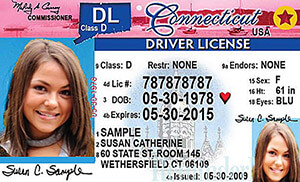

All your missed questions are saved
automatically for extra practice.




It's a practice test that's automatically made up of all your missed questions. Once you finish this test, you’ll be able to revisit your Challenge Bank™ to practice and sharpen your skills.
View All PlansAdding difficult questions to Challenge Bank™ is an exclusive Premium feature. Unlock access to 650+ exam-like questions, a Pass Guarantee, personalized study plans, and more.
View All PlansConnecticut DMV Fines and Limits Permit Practice Test 2025
- Perfect for learner’s permit, driver’s license, and Senior Refresher Test
- Based on official Connecticut Driver's manual
- Triple-checked for accuracy
- Updated for July 2025
In Connecticut, what are some offenses that can cause the license of a 16- or 17-year-old driver to be suspended? If you are found guilty of speeding at over 85 mph, what penalties may you face? If you refuse to submit to a test of your blood alcohol content (BAC), how long will your license be suspended? What restrictions usually apply to newly licensed drivers under 18 years of age, and are there any exemptions from these restrictions?
These and other issues related to licensing and traffic offenses are addressed in this free Connecticut Fines and Limits permit practice test. You’ll learn about the license suspensions imposed for certain traffic offenses, the possible penalties for driving under the influence (DUI) or leaving the scene of an accident (hit and run), and offenses that can cause license suspension or revocation. You’ll also learn about the restrictions placed on a driver under 18 years of age and circumstances that can exempt the driver from these restrictions.
This Connecticut Fines and Limits permit practice test is up to date as of July 2025. The 50 questions on this practice test are based on Connecticut’s official driver’s manual (Connecticut DMV Handbook (CT Driver's Manual) 2025) and the Connecticut General Statutes. As with all the permit practice tests we offer, each question on the Connecticut Fines and Limits permit practice test comes with our automated assistant. It can help you answer a question by providing a hint or an explanation of the correct answer.
In Connecticut from January 1, 2015, through November 1, 2024, there were 1,023,062 total traffic crashes, including 2,697 fatal crashes, involving 2,870 fatalities. These fatal crashes included 554 fatal pedestrian crashes. 333,381 (32.6%) of the total crashes and 760 (28.2%) of the fatal crashes involved at least one driver under 26 years of age. 85,664 (8.4%) of the total crashes and 946 (35.1%) of the fatal crashes involved at least one driver who was speeding. 28,824 (2.8%) of the total crashes and 733 (27.2%) of the fatal crashes involved at least one driver who was driving under the influence of drugs or alcohol. (Note: These factors are not mutually exclusive. Some drivers may have been speeding and under the influence at the same time.)
The regulations and penalties addressed by this practice test can be hard to memorize. But you should know them for your learner’s permit knowledge test and as a driver. Knowing what can happen if you do something wrong on the road can help make you a safer driver.
About this test

What to expect on the actual CT DMV exam
questions
correct answers to pass
passing score
minimum age to apply
More resources
Are you in another state?
- Alabama: Test 1 / Test 2
- Alaska: Test 1 / Test 2
- Arizona: Test 1 / Test 2
- Arkansas: Test 1 / Test 2
- California: Test 1 / Test 2
- Colorado: Test 1 / Test 2
- Connecticut: Test 1 / Test 2
- Delaware: Test 1 / Test 2
- District of Columbia: Test 1 / Test 2
- Florida: Test 1 / Test 2
- Georgia: Test 1 / Test 2
- Hawaii: Test 1 / Test 2
- Idaho: Test 1 / Test 2
- Illinois: Test 1 / Test 2
- Indiana: Test 1 / Test 2
- Iowa: Test 1 / Test 2
- Kansas: Test 1 / Test 2
- Kentucky: Test 1 / Test 2
- Louisiana: Test 1 / Test 2
- Maine: Test 1 / Test 2
- Maryland: Test 1 / Test 2
- Massachusetts: Test 1 / Test 2
- Michigan: Test 1 / Test 2
- Minnesota: Test 1 / Test 2
- Mississippi: Test 1 / Test 2
- Missouri: Test 1 / Test 2
- Montana: Test 1 / Test 2
- Nebraska: Test 1 / Test 2
- Nevada: Test 1 / Test 2
- New Hampshire: Test 1 / Test 2
- New Jersey: Test 1 / Test 2
- New Mexico: Test 1 / Test 2
- New York: Test 1 / Test 2
- North Carolina: Test 1 / Test 2
- North Dakota: Test 1 / Test 2
- Ohio: Test 1 / Test 2
- Oklahoma: Test 1 / Test 2
- Oregon: Test 1 / Test 2
- Pennsylvania: Test 1 / Test 2
- Rhode Island: Test 1 / Test 2
- South Carolina: Test 1 / Test 2
- South Dakota: Test 1 / Test 2
- Tennessee: Test 1 / Test 2
- Texas: Test 1 / Test 2
- Utah: Test 1 / Test 2
- Vermont: Test 1 / Test 2
- Virginia: Test 1 / Test 2
- Washington: Test 1 / Test 2
- West Virginia: Test 1 / Test 2
- Wisconsin: Test 1 / Test 2
- Wyoming: Test 1 / Test 2
